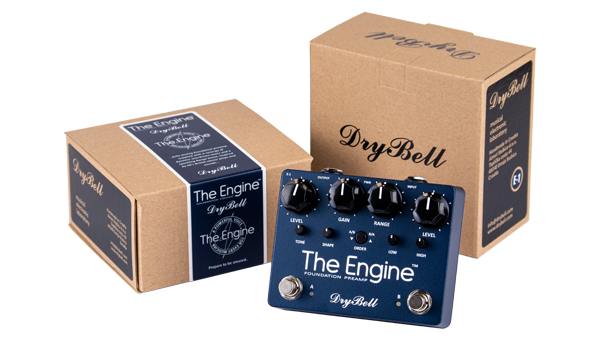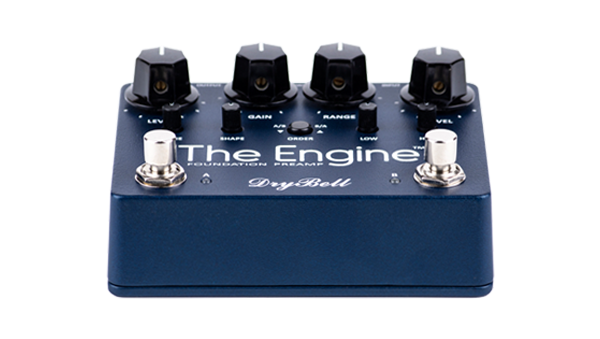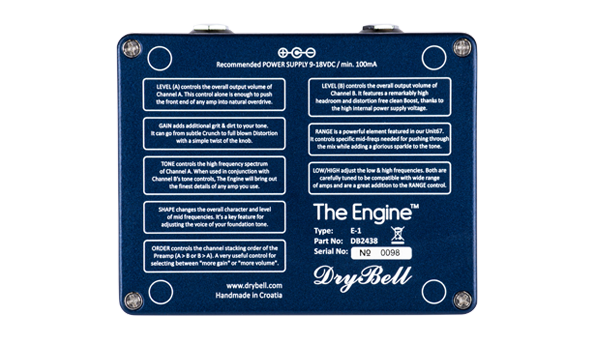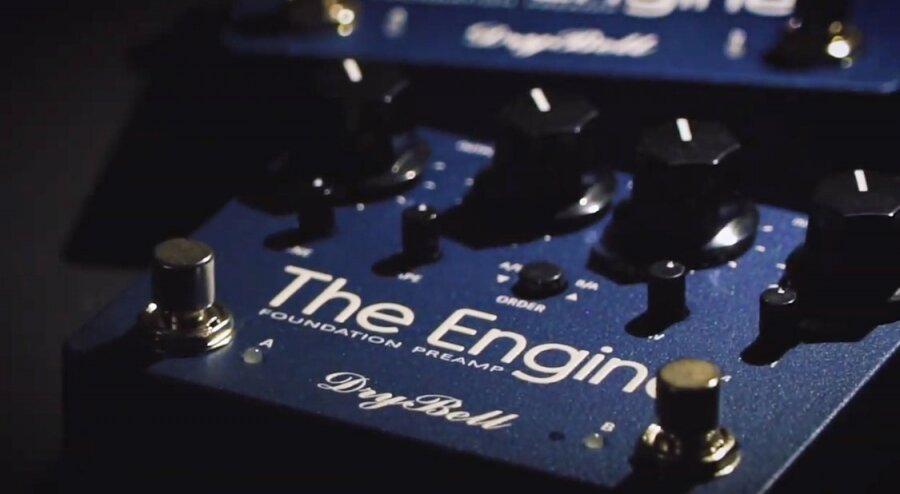Hello Gearheads! If there’s anything that can quench the mighty thirst of a dyed in wool pedal aficionado, the mystical “AMP IN A BOX” pedal could be a top contender. Since the dawn of time we’ve been trying to figure out how to get the loudest sounds… well, less loud. We want what we want and we want it NOW! Humor aside, the pedal market boom is chock full of circuits claiming to be a wide variety of “In a Box” scenarios. Many are good, enjoyable and some are great. The Engine Foundation Preamp from the beautiful geniuses at DryBell in Croatia fall into the latter category.
Simply put, The Engine is an incredible sounding and feeling pedal. It offers a wonderful range of gain, volume and EQ options - all surprisingly easy to use and you can quickly dial in to your needs. While most Amp In A Box or “AIAB” type pedals seem to offer massive amounts of control over the gain structure, the EQ, the compression and so on - The Engine has a very intuitive and simple layout. It’s reminiscent of the most familiar pedals even though there are indeed 9 knobs and 2 footswitches. What you’re left with is one fantastic overdrive and distortion box that not only sounds like a vintage British tube amp… but feels like one!
You might be asking, so what exactly separates The Engine from the piles of other pedals claiming to do the same thing? Well, that answer is simple… It just does! The Engine immediately felt like a real amplifier, a late 60’s British juggernaut of an amplifier to be exact. The familiar midrange oomph and “Karang”, the low end chunk that doesn’t feel bloated but somehow feels like there’s a 4x12 cabinet right behind your heels, the singing high end that’s not piercing in the slightest… this IS, in my opinion, the closest thing I’ve felt and heard to a real deal vintage 4 hole Marshall mid to late 60’s amplifier. The way the pedal feels under your fingers, the way the notes bloom into subtle and beautifully harmonic rich undertones… it’s a thing of beauty!
This thing of beauty is of course accompanied by a boost! Yay! We all love boosts, right!? Well, it’s not just any ordinary linear clean boost. It’s a perfectly voiced boost circuit that allows you blend in a Rangemaster circuit. The Rangemaster of course being the sound of so much fantastic music… Queen, Clapton, Sabbath, Rory Gallagher, the list literally goes on. DryBell have incorporated their Rangemaster circuit from the fantastic “Unit 67” Rangemaster/EQ/Compressor pedal. The Boost circuit in The Engine allows you to really dial in anything from thin, mean and raspy all the way to full range clean boosting. What’s great is the folks at DryBell have given you a button to flip/flop the Boost circuit to allow you to either (put it before) boost the overdrive portion and create more gain and saturation, or (put it after) and boost the whole pedal creating a major volume jump if needed. This is specifically helpful if you’re running a lower wattage amplifier that doesn’t need any extra saturation or compression and could really just benefit from a volume jump for those solo moments.
The control set on The Engine is quite possibly my favorite aspect of the design element. Nothing is frivolous here, everything has it’s purpose and does so much with so little. It’s a very valuable trait in any gear that I own or find interest in to have a simple yet powerful design. Nothing can utterly destroy a moment of creativity more than option paralysis or having to switch your mindset from art to tech. It’s never fun and almost always ruins the momentum. Many of the greatest producers and session players live and die by this rule for very real reasons. Always keep the momentum.
Here’s a bit from DryBell on their explanation on the two channels…
“Side A is very carefully tuned to capture the sound, feel and dynamic response of a real 60’s British NMV amp. It’s open sounding and very touch sensitive so the amount of dirt on tap is easily controlled by your pick attack. Besides familiar controls such as Level, Gain and Tone, we have added a special feature called Shape. It is a unique control which helps you adjust the overall character and level of the mid frequencies. It’s a key feature for adjusting the voice of your foundation tone and it can really help you fine tune the tonal details in your sound on any amp that you’re playing.
Side B‘s most powerful feature, Range(master) is our take on the Treble Booster from the 60’s. Range controls specific mid-frequencies whose complex overtones are great for pushing through the mix, whilst also adding some of the nicest sounding sparkle to your tone. Besides that, high headroom and distortion-free Clean Boost (thanks to the high internal power supply voltage) and versatile Low & High EQ will help you even further in tailoring your tone. For those of you who are familiar with our Unit67, think of this section as a Unit67, but without the compressor.
Both The Engine’s sections share a high headroom ultra-low noise buffer, designed to have no signal loss. Given that we use only long-life highly reliable components, your Engine will be running for years and years to come.
We wanted to give you that Tube-amp saturation which cleans up nicely with your guitar’s volume knob. Special attention has been given to the note separation and clarity at every stage of The Engine, even at its Hi-Gain settings. You will find that the signal-to-noise ratio is excellent for such high-gain tones.
Although The Engine has these two completely separate sections, it really shines when they are working together!
Stacking these two sides can yield some incredibly rich sounds. To help you answer the million dollar question: “Boost in front or after OD/Distortion?”, we created what we see as an essential feature called Order.
With the Order switch, you can choose the stacking order of the A&B sections. If you choose the right side B to go into left side A, the result will be much more distortion and complex overtones, depending on your settings. If you choose the left side A to go into B, the final result will be much more volume (if your amp has enough clean headroom) and much more sparkle and detail in your tone. It’s a really fun way to explore your tone with different settings and really helps in terms of pedalboard position.”
In the video demo below, I’ve used The Engine on all the stringed instruments including the bass guitar. The Boost or B section of the pedal offers a wide variety of tones that sound great in the track. The solo tone is both the A & B sections of the pedal, with B (set to Rangemaster at about 2:00 - 3:00) boosting A. The tones are rich, full and very dynamic. I’m looking forward to using The Engine for a long while to come.
Lastly, The Engine not only reacts exceedingly well with your guitar’s volume control (something that if you’ve read my Gearheads content before, you know is important to me) but it’s also one, if not the quietest, dirt box I’ve ever come across - the noise floor is essentially non exisitent. I’m not sure how you crazy cats at DryBell accomplished that one… but I’m sure happy you did. I’m looking forward to putting this on my pedalboard as soon as possible!
To learn more about DryBell & The Engine click here: http://drybell.com/the-engine/





